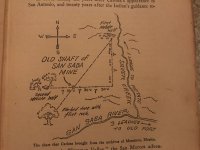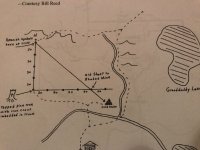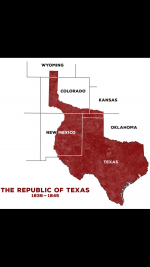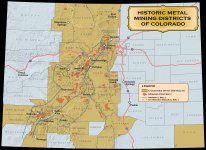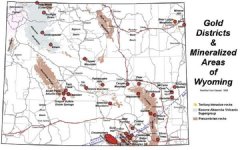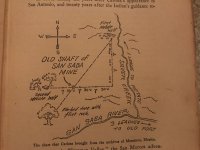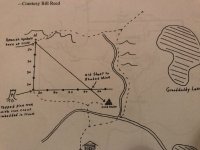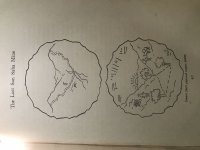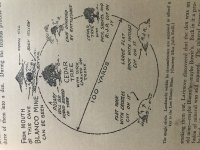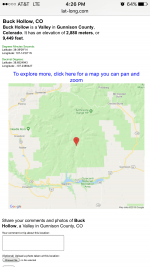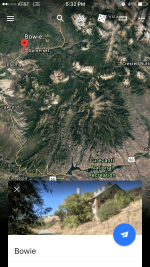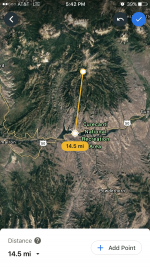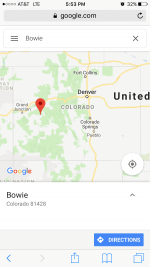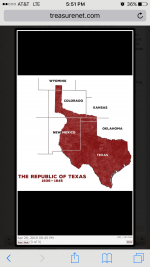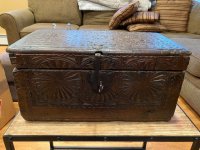research guy
Jr. Member
Concerning the San Saba mine. I'm not claiming to be any kind of expert here on the San Saba mine, but there are some things I've found that I would like to address. I have a first edition "Coronado's Children" by J. Frank Dobie, 1931. In this book the first 61 pages are dedicated to the San Saba mine. On page 55 we find a map. When I first saw this map, I immediately recognized it as being very similar to another map I've seen in Borens "the gold of Carre-Shinob" page 196. Obviously there is some striking resemblances between these two maps.
According to Boren, the Macginnis map was drawn by Elzy Lay, aka Bill Macginnis, and given to the governor of New Mexico to secure his own release from the New Mexico penitentiary.
For obvious reasons, the Macginnis map should be considered suspect. It was his golden ticket out of prison, and the proposed location of where he claimed it to be was States away from Texas. Or was it?
This Bowie story takes place in 1832ish. The one thing I know about treasure hunters is that they tend to give you lots of truthful information, but they leave out the useful information that you would require to do anything with it.
Now I'm not an expert on the San Saba mine, but one thing I do know for sure, is that Texas hasn't always been the Texas you tend to think of when looking at a map, particularity when you are discussing the 1830s. This is kinda the same problem you get into when it is said that cibola is in New Mexico. New Mexico didn't exists in coronados time, but new Spain did.
Part of New Spain eventually became New Mexico, and Texas was also part of New Spain . One thing that can be deduced from both of these maps and the information provided from them, is that both Utah and Texas at one time were both considered New Spain. Something that may need be considered is what Texas looked like in 1830s, when Bowie went looking for it. All of the sudden, Texas isn't so far away from what would eventually be called Utah.
I'm not into conspiracy theories, and some would consider what I'm suggesting exactly that. Bowie was hunting treasure. Elzy Lay was part of the Cassidy/Sundance gang. All things being equal, is it possible that San Saba mine was located both in Texas and near Utah in the 1830s? If either of these men were truly telling the whole truth, would we currently be still looking for the San Saba mine? I seem to remember that Colorado had a pretty massive silver mine in its own rights, and you could get there going south from Wyoming. Was Elzy lay mistaken or purposefully misleading about his information?
I'm not claiming to be right on any of the things I'm discussing above. I do believe that it's worth considering. And maybe it will give someone a new direction to address this lost mine. Texas wasn't always the Texas you tend to think of, particularity in Bowies time.
Food for thought!
According to Boren, the Macginnis map was drawn by Elzy Lay, aka Bill Macginnis, and given to the governor of New Mexico to secure his own release from the New Mexico penitentiary.
For obvious reasons, the Macginnis map should be considered suspect. It was his golden ticket out of prison, and the proposed location of where he claimed it to be was States away from Texas. Or was it?
This Bowie story takes place in 1832ish. The one thing I know about treasure hunters is that they tend to give you lots of truthful information, but they leave out the useful information that you would require to do anything with it.
Now I'm not an expert on the San Saba mine, but one thing I do know for sure, is that Texas hasn't always been the Texas you tend to think of when looking at a map, particularity when you are discussing the 1830s. This is kinda the same problem you get into when it is said that cibola is in New Mexico. New Mexico didn't exists in coronados time, but new Spain did.
Part of New Spain eventually became New Mexico, and Texas was also part of New Spain . One thing that can be deduced from both of these maps and the information provided from them, is that both Utah and Texas at one time were both considered New Spain. Something that may need be considered is what Texas looked like in 1830s, when Bowie went looking for it. All of the sudden, Texas isn't so far away from what would eventually be called Utah.
I'm not into conspiracy theories, and some would consider what I'm suggesting exactly that. Bowie was hunting treasure. Elzy Lay was part of the Cassidy/Sundance gang. All things being equal, is it possible that San Saba mine was located both in Texas and near Utah in the 1830s? If either of these men were truly telling the whole truth, would we currently be still looking for the San Saba mine? I seem to remember that Colorado had a pretty massive silver mine in its own rights, and you could get there going south from Wyoming. Was Elzy lay mistaken or purposefully misleading about his information?
I'm not claiming to be right on any of the things I'm discussing above. I do believe that it's worth considering. And maybe it will give someone a new direction to address this lost mine. Texas wasn't always the Texas you tend to think of, particularity in Bowies time.
Food for thought!


